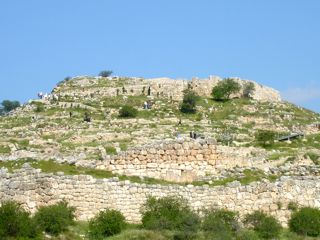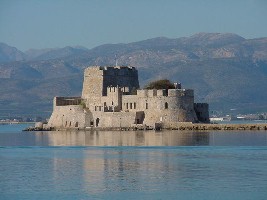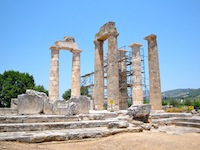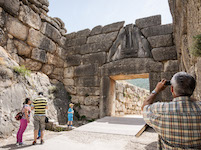
Corinth Canal and Isthmia
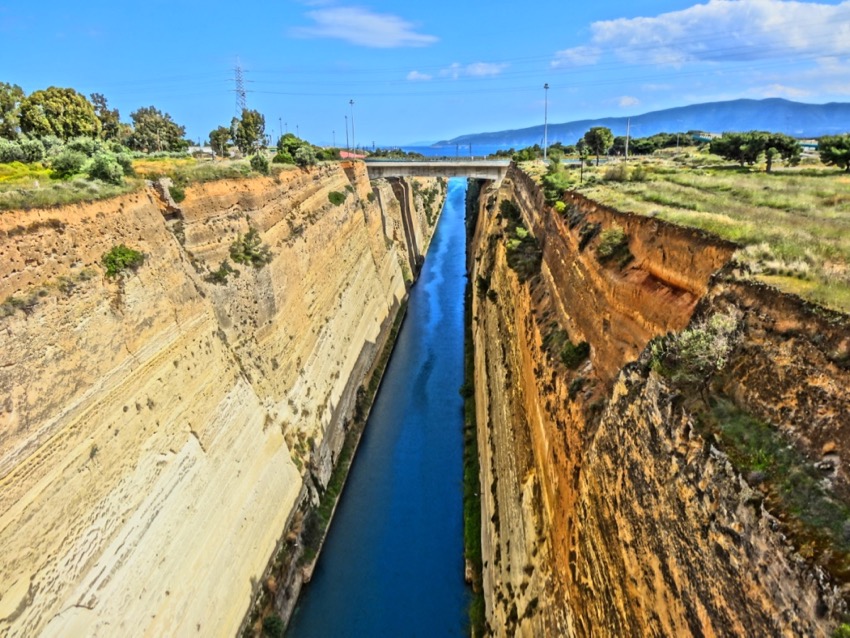
Ships on Wheels, Herakles' 13th Labour, and a Fisherman Made from Glass
|
|
Apart from the remains of the Temple of Apollon, the Fountain of Glauke, the Temple of Octavia, the Roman Agora, the Sacred Fountain, and the Fountain of Peirene, the most prominent feature of the archaeological site of Ancient Corinth is the so-called Lechaion Road. Its marble surface, steps, and pavements are well preserved, and the presence of porticos, galleries, and gutters show a level of urbanisation that would befit any modern city today. The Lechaion road leads from the centre of the city to the North, all the way to the Gulf of Corinth and one of the two harbours that made the Ancient Corinthians famous, rich, and cultivated: Lechaion. |
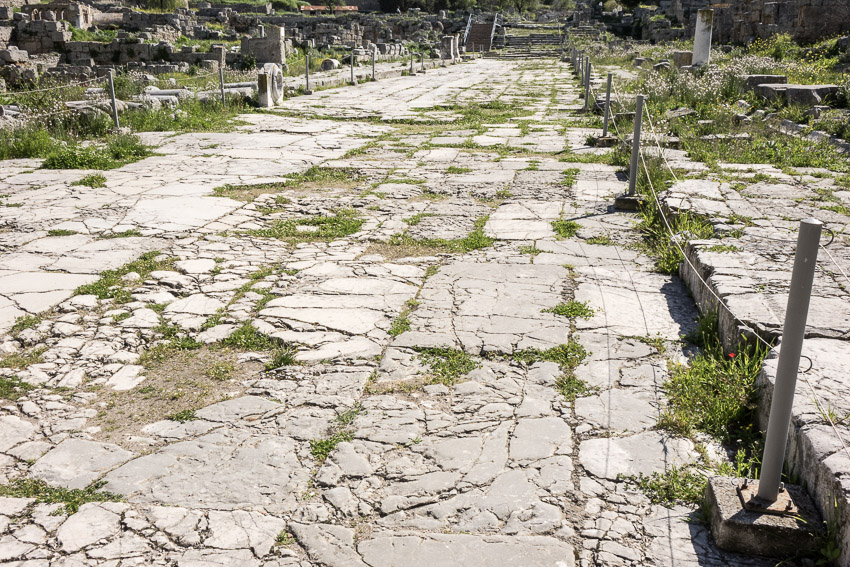 |
|
The harbour of Lechaion is currently being excavated by a team of Danish (underwater)archaeologists. Their findings have so far more than confirmed the importance and magnitude of the harbour. What today looks like a marshy lagoon with the ruins of the largest ancient Christian basilica of Greece next to it, was once a very well-protected inner-harbour where cargo ships could safely load or unload goods coming from or going to the East or West side of the Mediterranean. Ancient Corinth had not only founded many colonies in the South of Italy, Sicily, and on the West and East coasts of the Greek mainland, it also controlled the most important maritime traffic node between the Adriatic and Ionian Sea to the West and the Aegean Sea to the East: the Isthmos. Most ships sailing at the time would try and stay in proximity of land and thus of safe harbours, in order to avoid storms at sea. So most ships sailing between the West and the East of the Mediterranean would have had a choice: either sail around the South coast of the Peloponnese which was a treacherous route with many storms and a coastline that caused many a shipwreck, or pass directly from the Corinthian to the Saronic Gulf, a fast and safe shortcut, but a shortcut that came with a price: toll that would have to be paid to Ancient Corinth for the use of its technological pride, the Diolkos. |
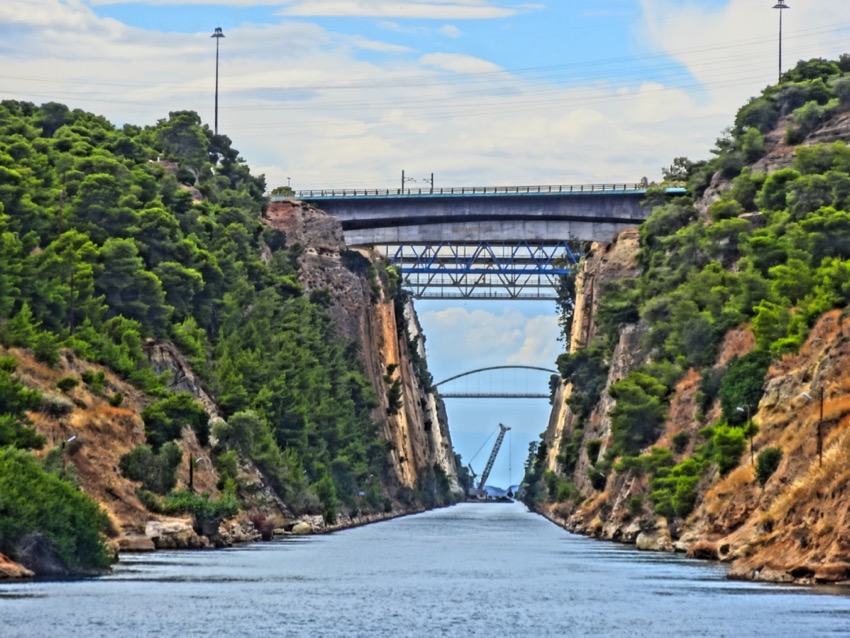 |
|
Although the Canal of Corinth is a mere 125 years old, several rulers in Classical Antiquity already thought of digging a cutting through the Isthmos, the narrow strip of land that connected the Peloponnese to the rest of the mainland of Greece. Periander, tyrant of Corinth at the end of the 7th and beginning of the 6th century BCE and one of the Seven Sages of Greece, was the first to come up with the idea of such a canal. However, for a reason we can only speculate about, he abandoned the initial project and came up with a cheaper alternative: the Diolkos, a stone carriageway along which ships could be towed from one side of the Isthmos to the other whilst their cargo would be transported from Lechaion to Kenchreai, the second harbour of Corinth in the Saronic Gulf. Measuring between 6 km (3.8 mi) and 8.5 km (5.3 mi) in length, this paved trackway was in operation from around 600 BCE until at least the middle of the 1st century CE, possibly even longer. It was paved with hard limestone blocks and was between 3.5 and 6 metres wide, with parallel grooves running 1.6 metres apart. These tracks and other archaeological evidence prove that transport of the ships was done with a kind of wheeled vehicle that was pulled and/or pushed by men and/or animals using ropes, pulleys, and capstans. |
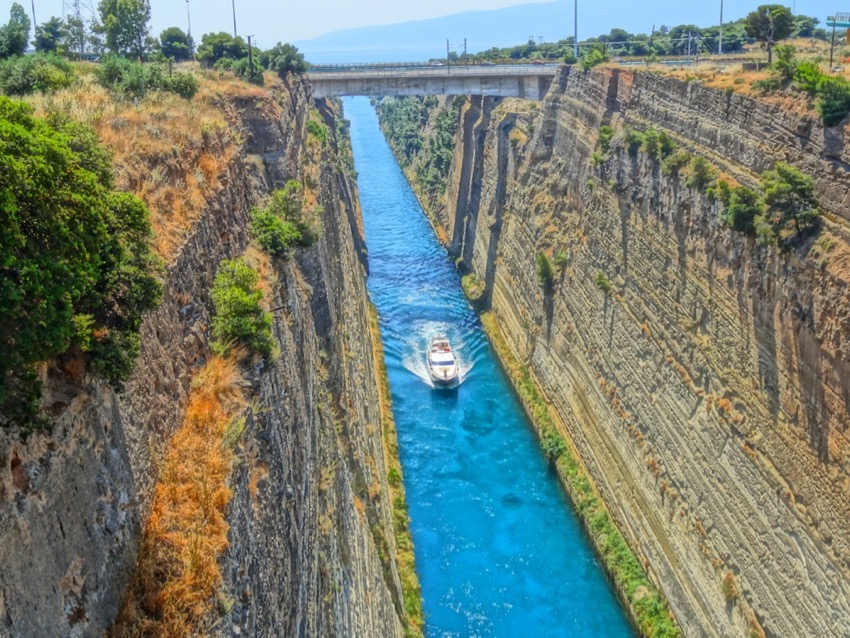 |
|
There are a number of theories about how many men would have been needed (between 100 and 150?) and how long it would have taken to transport a ship from one side of the Isthmos to the other (most probably 3 hours). Unfortunately, the ancient written sources that mention the existence and the use of the Diolkos, don't give us the answers to these questions. Perhaps even more unfortunately, the few archaeological remains of the Diolkos that still exist today in the area around the NW entrance of the Canal, are not very well protected (apart from a larger section of a few hundred meters that is now on the domain of a Military Engineering School) and don't yield much information either. In general the procedure must have been as follows. The ship would first unload its cargo and crew in one harbour to make it as light as possible. It would then sail to one side of the Isthmos and manoeuvre into shallow waters where it could be towed onto a wheeled vehicle which, at that moment, would be submerged as the trackway probably began already under water (this seems to be the case in the still visible mooring area at the NW end of the Diolkos). The vehicle would then transport the ship over the Isthmos where, at the other side, the ship would be lowered into the water to pick up its cargo in the second harbour. Although I am not an engineer and this is not the moment nor the place to elaborate any further, I do have my own theory regarding the engineering methods that could have been used to transport the ship on top of a wheeled vehicle riding in grooves on a paved trackway climbing up and down the 79 metres high Isthmos ridge, without the need of more than a dozen men. If there are any engineers out there who would like to help me do further research into this possibility, I'm only an e-mail away... |
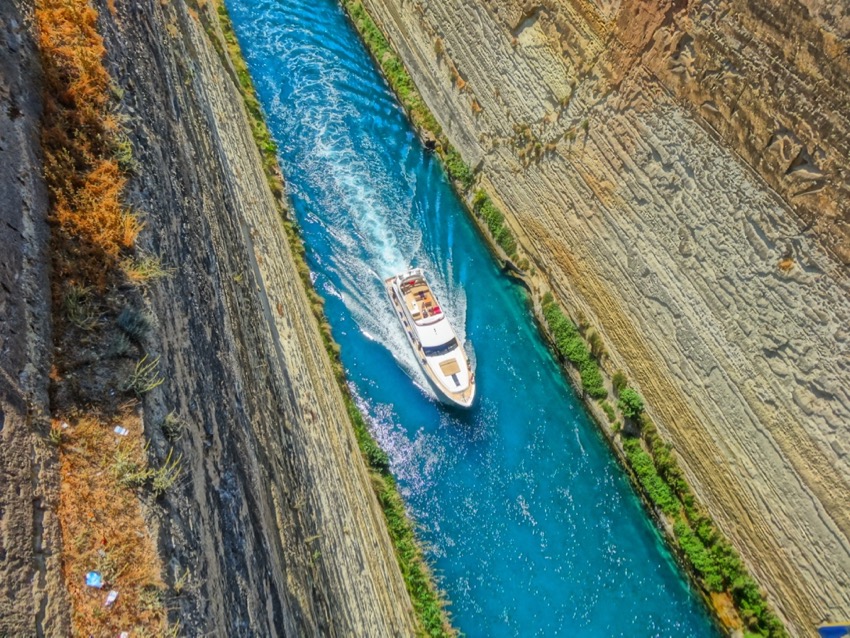 |
|
Transport of cargo ships over the Isthmos must have been the primary use of the Diolkos and the tolls were most certainly a very important source of income for Ancient Corinth. However, also military fleets could take full advantage of the shortcut that was provided as an alternative to the far longer and more dangerous route all around the Peloponnese passing the treacherous Capes Malea and Matapan. After the famous sea battle of Actium in 31 BCE which opposed the naval fleet of Marc Antony and Cleopatra, Queen of Egypt, to that of Octavian, the latter used the Diolkos to have some of his fastest ships transported over the Isthmos in his pursuit of Marc Antony, who had left the battle and was following Cleopatra back to Egypt, all due to a serious communication error. |
 |
|
All technological advance comes at a price, however, and unfortunately the digging of the famous Canal of Corinth at the end of the 19th century has destroyed most of what remained of the Diolkos until then. The only parts of it that can still be seen by the public today are situated near the submergible bridge at the NW entrance of the Canal next to the road between modern-day Corinth and Loutraki. In the late 1950s and early 1960s Greek archaeologist Nikolaos Verdelis excavated several parts of the Diolkos, over a total length of about 1,100 metres, but because of his premature death his reports, which could have answered many important questions, were never fully published. |
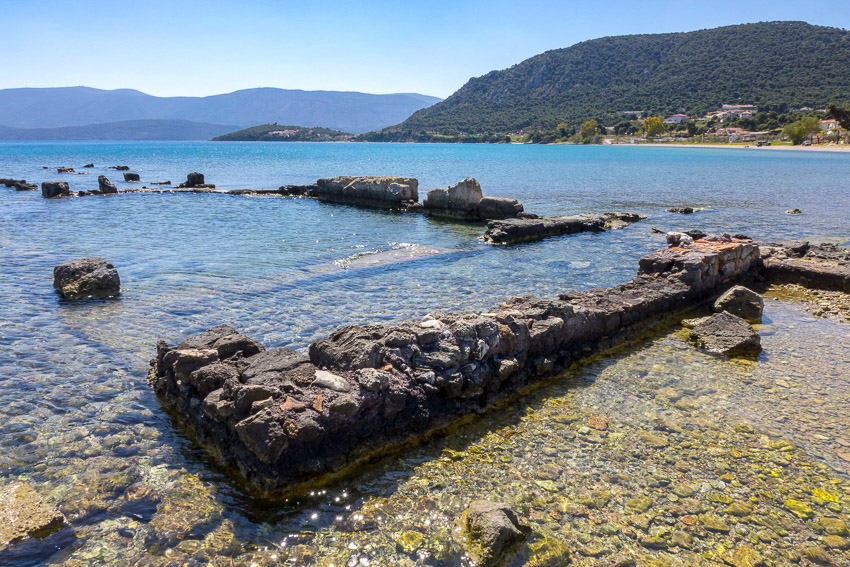 |
|
Just a few kilometres south of where the Diolkos would have joined the mooring area for the ships waiting in the Saronic Gulf, the ruins of a number of buildings in the Eastern harbour of Ancient Corinth, Kenchreai, can still be seen on and around the beach of modern-day Kechries. Amongst them is a building that was previously interpreted as a temple dedicated to the Egyptian Goddess Isis, but has now been identified as a Nymphaion. In 375 CE an earthquake caused the building to partially collapse and be submerged as the level of the sea rose several metres. However, 200 years before, Pausanias saw and noted down in his travel journal the presence of a Temple of Isis in this same area, the SW part of the harbour. Either the temple was transformed into a Nymphaion later on, or this is a different building altogether. Anyhow, I mention the Temple of Isis especially for those of you who have heard about or perhaps even read the "Metamorphoses" (aka The Golden Ass) by Apuleius (2nd century CE), as this temple features prominently in the novel. And I even mention it for those of you who have not heard about it and who would otherwise never read it: Go and get your copy in English translation now, it's incredibly entertaining and great fun to read. Lucius, the protagonist of the story, has an insatiable desire to see the effects of magic and practice it himself. So he tries out a spell that should change him into a bird, but instead transforms him into an ass, forcing him into a long journey full of adventures, both literal and metaphorical. Finally, he ends up in the Temple of Isis in Kenchreai where the Goddess breaks the spell and transforms him back into a man. If this wouldn't be enough to attract your attention to a place that once was one of the most famous harbours in Antiquity, then perhaps the fact that Beautiful Helen (of Sparta, or of Troy, as you like) reportedly took her baths in the bubbly waters of a thermal spring just a stone's throw away to the South of Kenchreai, might seduce you more effectively. The still surviving and very active outflow of the spring into the sea, can be visited and put to good use in the town with the most alluring name of "Loutra Oreas Elenis" (The Baths of the Beautiful Helen. The charming Bettany Hughes, a colleague of mine, has tested the positive effects of the thermal spring out herself and writes about the "invigorating" experience in her book "Helen of Troy: Goddess, Princess, Whore". |
 |
|
However useful the profits of the Diolkos and the two harbours must have been for the city of Corinth, Periander's original plan of digging a canal through the Isthmos never stopped fascinating a number of people. Some 300 years after Periander, the Macedonian Diadoch Demetrios Poliorketes had his engineers examine the possibility but they gave a negative advice because of the difference in water levels between the Gulf of Corinth and the Saronic Gulf, fearing the current inside the canal would be much too strong for safe navigation. Recent research has indeed shown that the levels of the two gulfs have varied a lot in the course of time, so this was no mistake by the ancient engineers as some modern-day authors would like us to believe. If you would already have read my article on Ancient Corinth, you will know that the Roman general Mummius sacked and burned the city in 146 BCE, killed or enslaved its citizens, stole most of the art and treasures, and laid the land around it to waste. When the Roman dictator Iulius Caesar rebuilt Corinth and made it into a Roman colony in 44 BCE, he too considered the idea of digging a canal through the Isthmos but before he could start the project, he was murdered. Around 40 CE the infamous Roman emperor Caligula copied Caesar's idea and ordered Egyptian engineers to do preliminary research. But that was as far as Caligula's plans came, as he too was assassinated. The emperor Nero, however, was more successful in 67 CE. He bravely (or should I say ceremoniously?) took a pickaxe, started digging, filled one basket with soil, and then left the rest of the job to his engineers and some 10,000 slaves, political and war prisoners, soldiers, and conscripted labourers. This huge workforce started digging 40 to 50 metre wide trenches at both sides of the Isthmos whilst on top of the ridge deep shafts were drilled to probe the quality of the limestone and sandstone rock. But when Nero died about a year later, all work on the canal stopped. A shame, really, because when the Hungarian engineer B. Gerster surveyed the Isthmos in the early 1880s before starting works on the current canal, he was impressed not only by the quality of the ancient engineering techniques but also by the extent of work that had been done by Nero's workforce - the results of which still very much visible at the time of his survey. Gerster noted in his reports how more than 18 centuries before, in less than one year, more than half of the length of the canal had been dug down to a considerable depth (up to 30 to 40 metres deep) and how 700 metres out of the total 6.4 kilometres had been completely finished, down to sea level. This equated to a staggering 1 million cubic metres of earth and stones that had been dug out, transported, and dumped in the area around the canal in Nero's time - almost 1/10th of what had to be dug out and moved during the construction of the modern canal at the end of the 19th century, which could rely on the use of dynamite and steam locomotives. Unfortunately for archaeology, construction of the modern canal followed the exact same route as the one that Nero's engineers and workforce had traced and partially dug out. The route straight from the Corinthian Gulf to the Saronic Gulf not only proved to be the best option for geological and engineering reasons, but was obviously also the most economical one, as the 19th century construction works took full advantage of the digging that had been done by Nero's workforce some 1800 years before. Unfortunately, no serious archaeological survey or excavation was performed to identify, map, and document the remains of the ancient canal before they disappeared. However, on the Peloponnesian side of the canal near the Corinthian Gulf, it is still possible to see that some of the limestone and sandstone walls of the current canal actually belong to the canal works of Nero's time instead of those of the 19th century, as they carry the distinctive marks of ancient chiselling. It is in those same walls that in Roman times a relief was carved, which is also still visible but very much subject to wind and water erosion. The relief carries the figure of the emperor Nero, dressed as Herakles holding his famous wooden club, and refers to the hero's Twelve Labours, now having a thirteenth one added to. |
|
|
|
Inspired by Nero's initiative, the Greek aristocrat, philosopher, and Roman senator Herodes Attikos (the one of the famous Odeion at the foot of the Akropolis in Athens) considered funding an attempt to continue digging the canal in the 2nd century CE, but nothing came of it. And neither the Venetians managed to start up the works again when they had conquered the Peloponnese in 1687, one and a half millennium later. When Greece became independent in 1830, its first head of state, Ioannis Kapodistrias, also thought of finishing the canal, but the estimated costs were far too high to make that dream come true. The opening of the Suez Canal in 1869 made the Greek government re-assess the possibility and soon after, a law was passed allowing the construction of the Canal of Corinth as we now know it. French investors took up the challenge but financial troubles leading to a bankruptcy meant that a new company (the "Société Internationale du Canal Maritime de Corinthe") had to be founded, responsible for the construction and future exploitation of the canal for a period of 99 years. King George I of Greece inaugurated the construction on April 23rd, 1882, but somehow Herakles didn't really fancy the idea that a French company would claim his thirteenth labour because once again bankruptcy stopped all construction work soon after it had begun. It was only when the project was transferred to a Greek company, that the canal became a reality. After 11 years of hard work, on July 25th 1893, the first ship could navigate directly from the Corinthian into the Saronic Gulf. |
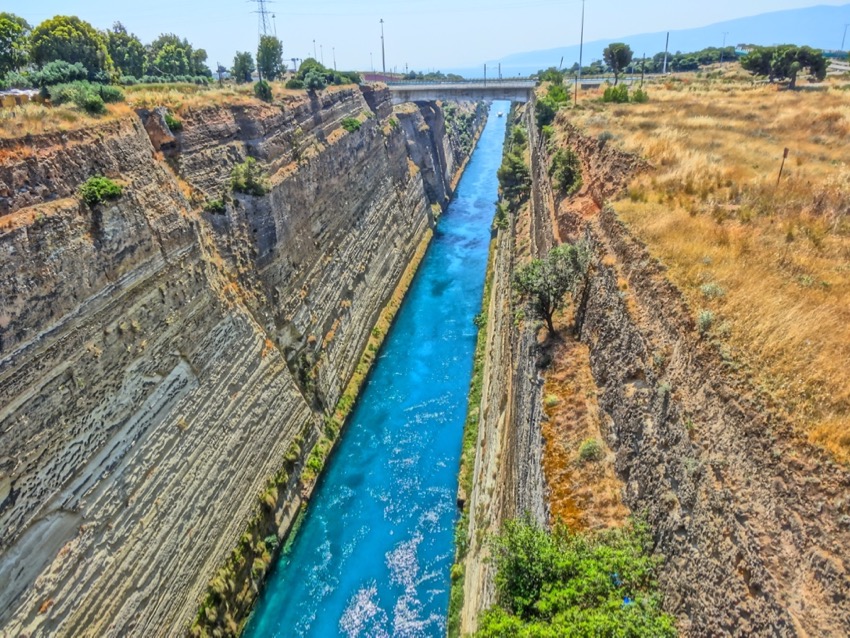 |
|
Unfortunately, even after its completion the canal continued to be plagued by financial and operational troubles. It simply did not manage to attract the amount of maritime traffic that had been expected, for two main reasons. First, shipbuilding had made serious progress since the project had started, so the newest ships that were taller and wider than ever before, could not navigate easily enough through the narrow and deep canal because of the strong winds that often blow through it and because of its strong currents that are caused by the different times of the tides in the two gulfs. Second, the inherent instability of the limestone and sandstone walls of the canal together with frequent seismic activity in the area caused and still cause landslides. Stabilising the high walls and clearing out several thousands of cubic metres of material that more or less regularly fall into the water, demand serious maintenance and temporary (often quite long) closures of the canal. During the writing of this article in March 2018, two subsequent landslides occurred, forcing the canal to be closed for an investigation into the cause, for the clearing out of the canal, and for the necessary repairs to the walls. During the invasion of the German military forces into Greece in Spring 1941 when the main bridge was defended by British troops, the canal was heavily damaged during the German assault. And three years later, when the German troops retreated, they used explosives to cause landslides and did all they could to block the canal and make repairs to it extremely difficult, by dumping not only the bridge wreckage but even complete locomotives and wagons into it. Afterwards, it took the United States Army Corps of Engineers almost a full year to clear the canal. For those of you who like numbers: the canal was constructed at sea level so no locks would be necessary, it is 8 metres deep and 6.3 kilometres long. At the top of the walls it is 24.6 metres wide, and 21.3 metres wide at the bottom. The rock walls rise 90 metres above sea level at their highest point (roughly in the middle of the canal) and form a near-vertical 80 degrees angle. The canal is currently crossed by two railway lines, three roads, a footbridge, and a motorway. In 1988 two submersible bridges were installed at each end of the canal, by the western harbour of Poseidonia and the eastern one of Isthmia. When ships enter the canal, the bridges are lowered vertically using an elevator-like system until they completely disappear under the water and the ships can pass over them. The canal is nowadays mostly used by tourist ships, yachts, and some smaller cargo ships. They have to pass the canal in a convoy using a one-way system which is monitored in two towers, one at each end. In 2014 some 11,000 ships used the canal's shortcut through the Isthmos instead of navigating the 700 kilometres around the Peloponnese. |
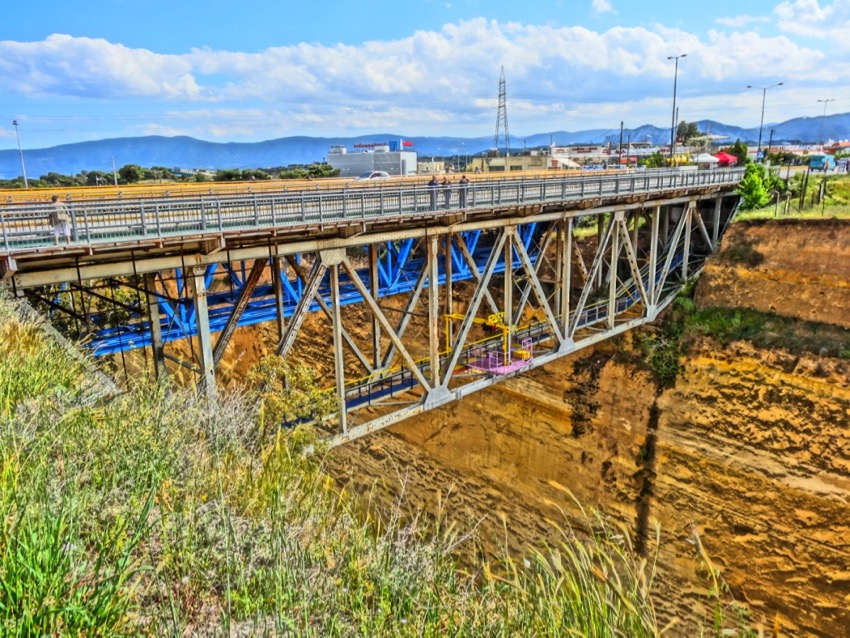 |
Ancient Isthmia |
|
Often overlooked (not to say almost unknown) but certainly worth a visit are the archaeological site and museum of Isthmia, just a few minutes away from the canal. The most important architectural remains on the site are the ruins of the Temple of Poseidon, the Sanctuary of Melikertes-Palaimon, part of the ancient Stadium and its starting grid, a theatre, and a very impressive Roman bathhouse. The museum possesses some very unique and beautiful artefacts that were found at the site, around Isthmia, and in the harbour of Kenchreai. The origins of the Sanctuary in Isthmia go back to at least the first half of the 7th century BCE when the first Naos (or 'temple' in Greek) dedicated to Poseidon was built, which makes it more or less contemporary to the Temple of Apollon in the centre of Ancient Corinth. Both temples represent the first examples of monumental architecture in Greece. However, the Naos of Poseidon, at that time the largest in the whole of Greece, featured wooden columns as opposed to the massive monolithic stone columns of Apollon's Naos in Corinth. Poseidon's abode also had a tiled roof that sloped equally on all four sides as opposed to having two sides meet in the middle to form pediments at either end, as is the case in later, "classical" temple architecture. Unfortunately, this beautiful Archaic temple was destroyed by fire in 470 BCE. A few years after the disaster a new temple was built, this time in classical style and completely in stone, but it suffered the same fate as the Archaic one as it fell prey to the flames in 390 BCE. Shortly afterwards, a third temple was built, again on top of the previous one, as the site flourished once more as a religious and cultural centre and was inhabited at least until the 6th century CE. |
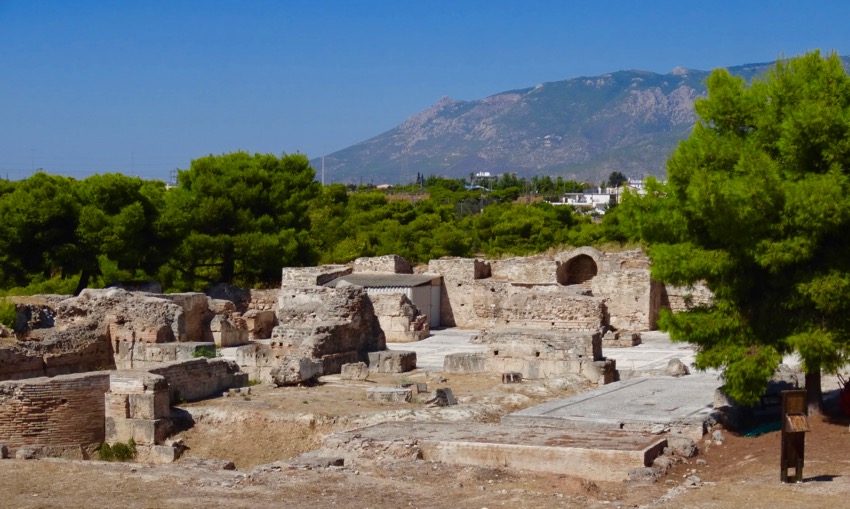 |
|
Surely, the Temple of Poseidon always was the most prominent architectural feature of the site, as it could be clearly seen from a considerable distance not only by travellers coming from the East on the road from Athens to Ancient Corinth but also by ships in the Saronic Gulf approaching the harbour of Kenchreai. However, Isthmia was also famous during many centuries for two other reasons: the Isthmian Games and the hero-cult of Melikertes-Palaimon. The Isthmian Games were held for the first time in or around 584 BCE. They were organised as a Panhellenic event and festival, meaning that all of the Greek city states and their colonies could send their athletes and artists (as there were also musical and poetical contests) to participate. Leaving aside the Games and the Festival that were organised at the Sanctuary of Asklepios in Epidauros, Panhellenic Games were held at four important centres in the Greek world: Olympia (officially the oldest and most famous), Delphi, Nemea, and Isthmia. The Olympic Games were held in honour of Zeus and Hera and had been founded by Pelops and Hippodameia as funeral games in commemoration of king Oinomaos (cf. the legend of Pelops and the chariot race between him and Oinomaos). The Pythian Games in Delphi were dedicated to Apollon as he had founded them himself having killed the Python snake, the son of Gaia, that had been sent by Hera to kill Apollon's mother Leto. The Nemean Games were in honour of Zeus as they were founded by Herakles upon killing the Nemean lion, although another legend explains how the Seven Generals from Argos on their way to Thebes (as a kind of prelude to Aischylos' tragedy "The Seven Against Thebes") were indirectly responsible for the death of Opheltes, the baby son of King Lykourgos and Queen Eurydike of Nemea. As such, the Seven organised the first Nemean Games as funeral games in Opheltes' memory. A similar tragic story involving the death of a young boy (and his mother) who drowned in the sea, and funeral games being held in his memory, is the origin of the Isthmian Games, organised under the auspices of Poseidon. The young boy's name was Melikertes (later called Palaimon) and it was none other than his uncle Sisyphos, the legendary founder of the city of Corinth, who found the dead body of the infant under a pine tree on the shore of Isthmia after it had been carried there by a dolphin. |
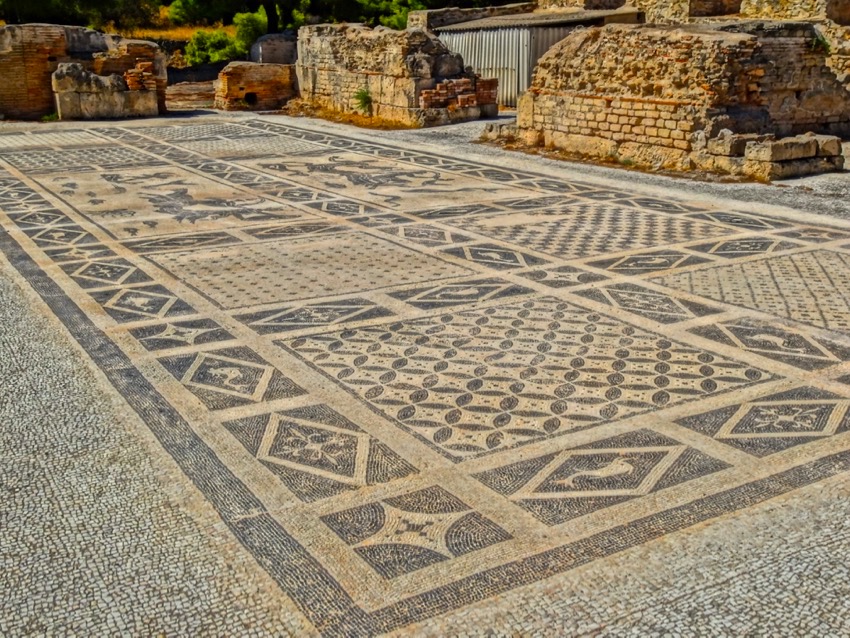 |
|
Archaeological excavations in Isthmia were organised by the Ohio State University and the University of Chicago, and have brought to light not only part of the original stadium but also remains of the Sanctuary of Melikertes-Palaimon, all in very close proximity to the Temple of Poseidon. The ubiquitous Pausanias visited Isthmia in the 2nd century CE and described both sanctuaries in his travel journal. Isthmia is, as most other archaeological sites in Greece, far from being completely excavated, but having taken a look at the remains of the temple of Poseidon and of the sanctuary of Melikertes-Palaimon, part of the ancient Greek stadium, and the theater, the visitor should definitely walk a little further to the Northern part of the site and admire what is currently its greatest treasure: the magnificent monochrome mosaic floor of the Roman bathhouse that was built around 150 CE over an earlier Greek structure featuring a pool. The elaborate building contained several decorated rooms and halls with vaulted ceilings, marble walls, and statues. The sophisticated heating and drainage systems of the complex are most impressive. But the black and white mosaic on the floor of the main hall is one of the finest examples of Roman craftsmanship: we see Nereids and Tritons, dolphins, all kinds of fishes, even an octopus, all surrounded by exquisite geometric patterns. |
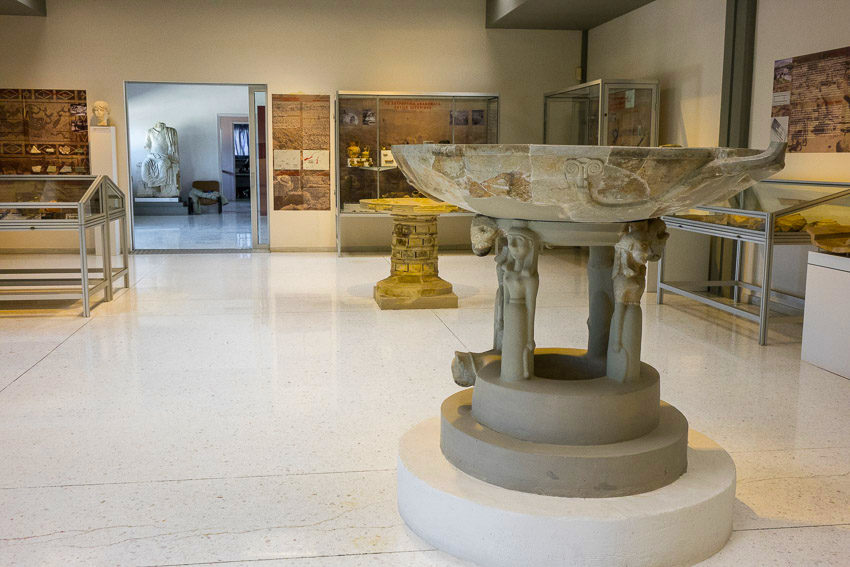 |
|
This is not the last of the surprises that Isthmia holds in store for us. One of the first objects that welcomes the visitor in the museum hall, is an exquisite lustral basin, carved out of marble and decorated with four female figures standing on lions. It originally stood in the peristyle (the space under the outer colonnade) of the first Naos of Poseidon and miraculously survived the blaze of the fire that destroyed the Archaic temple. I quote from the article "The Evolution of a Pan-Hellenic Sanctuary: From Archaeology towards History at Isthmia" as published on the website of the University of Chicago: << At the time of the fire the inside of the temple and its deep eastern porch were filled with offerings, most of which were badly damaged in the blaze. They included figurines of bronze and terracotta, chariots and horse trappings, small oil containers of clay and bronze and large storage vessels whose charred interiors reveal that they too contained oil. It is fortunate that perhaps the most elaborate dedication stood outside the cella in the northeast corner of the peristyle, well away from the center of the fire. The monument is a great marble basin (perirrhanterion) supported on an elaborate stand, the base for which is still in place. [...] The bowl, 1.24m in diameter, rests on a ring supported by four women, each standing on the back of a lion and holding in one hand the lion’s leash and in the other its tail. The ring between the women is decorated with rams’ heads. The exquisite stone carving is further embellished by paint on the hair, face, and clothing of the figures. The worn surfaces of its handles and rim bear witness to the many people that reached into it, presumably for water to purify themselves before entering the cella. The style of the carving makes the monument contemporary with the temple, or a little later. We cannot be certain where it originally stood, however, since its base was moved when the third floor was put into the peristyle, but the absence of weathering tells us that it was never exposed to the elements. Although basins of this type were popular in the seventh century, the Isthmian perirrhanterion is outstanding in the intricacy of its design and quality of execution. I think we can safely conclude that it was a major dedication. >> |
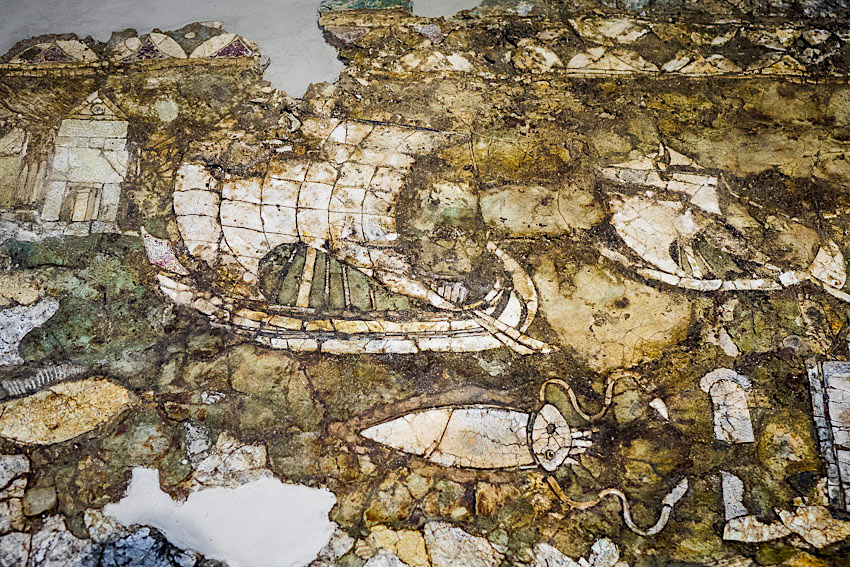 |
|
A little further we can admire a collection of bronze helmets dating from 700 to 480 BCE, a Hellenistic clay bathtub, some beautifully decorated ancient vases, fragments of furniture and chairs, and an incredibly rare, if not unique find: ancient but very well-preserved wooden doors from a building in the harbour of Kenchreai. At the very end of the exhibition hall one final and even more unique find takes my breath away every time I visit this museum. It is a collection of Roman glass panels from the end of the 4th century CE, which were discovered during the excavations in the harbour of Kenchreai. Only a small selection of the 87 panels is on display - the majority safely stored away in a special room under total environmental control for preservation and restoration purposes. The largest panels measure over 1.5 metre in length and over 0.5 metre in width. All of them together would have covered a surface area of 150 square metres and they would have weighed 700 kg. Even more amazing is the fact that the panels were discovered in their original wooden boxes that had been stacked against a wall of the very building that was originally interpreted as a Temple of Isis but has now been identified as a Nymphaion (i.e. a building that contains one or more fountains and a colonnade around a courtyard, plus rooms or halls where major art works would be displayed). This is the same building where the wooden doors were found and a number of fragments of beautifully decorated wooden chairs, also on display in the museum. |
 |
|
Disaster struck in the form of an earthquake that made a large part of the harbour of Kenchreai sink into the sea in 375 CE. The Nymphaion and other buildings around it partially collapsed, were inundated and covered by mud and debris, and the glass panels and other objects were never seen again until in the early 1960s a team of archaeologists from Chicago University found them "in situ". Unfortunately, the panels had been stacked in pairs facing each other and the centuries-long chemical reaction between the salty seawater and the glue that was used by the ancient artists, had caused them to be fused together. The thickness of two glass panels stuck together (one on each side) is approximately 12 mm. During the restoration of the panels in 1974-76 in the Corning Museum of Glass (New York), it was decided not to try and separate them as the risk of irreparable damage was too big. So in most cases the back side of the glass panels is what we are now looking at in the museum. |
|
It is important to understand that these are not mosaics (which are made of small pieces of marble, although mosaics occasionally contain a number of coloured pieces of glass for special visual effects). The glass panels of Kenchreai were made in the so-called "opus sectile" technique, containing larger and smaller pieces of coloured glass or glass paste. It is almost certain that they were meant to be installed as elaborate wall decorations in the building they were found in: the Nymphaion. Although the original colours of the panels (red, green, yellow, pink, white, purple, ochre, blue, and turquoise) must have been much more vibrant, the patina of time mixed with salty sea water has given the scenes an almost ethereal quality. We see landscapes, a harbour (perhaps Kenchreai itself?), temples, buildings, houses, human figures, the sea, ships, birds, a man fishing at the pier of the harbour, squid and fish swimming in the sea, and delicate geometric patterns. The other panels not on display show scenes from the Nile valley, and portraits of Gods and divine creatures flying in the sky, mythological figures, poets (a.o. Homeros), philosophers (a.o. Platon), and imperial officials or perhaps the donors of the panels. The scenes and portraits are mesmerising and moving. The fragile beauty and decorative delicacy of the glass panels are enchanting, and their almost miraculous survival and patient restoration allow us - if only for a fragmentary and artistically interpreted moment in time - to look through a window into the past. See also Ancient Corinth and Acrocorinth |
|
Angelos Asklepiades photographs and writes about his passion: archaeological sites and their history, legends, and stories. Based in the heartland of the Mycenaean civilisation, the Argolid, he explores mythical hills and magical valleys in search of ruins and roads that were seen and described by travellers of the 18th and 19th century. A master's degree in Classical Philology and Greek Archaeology helps him to share to a general public what colleagues in history, philology, and archaeology research, excavate, and publish. You can contact him at garden.of.the.muses@gmail.com |
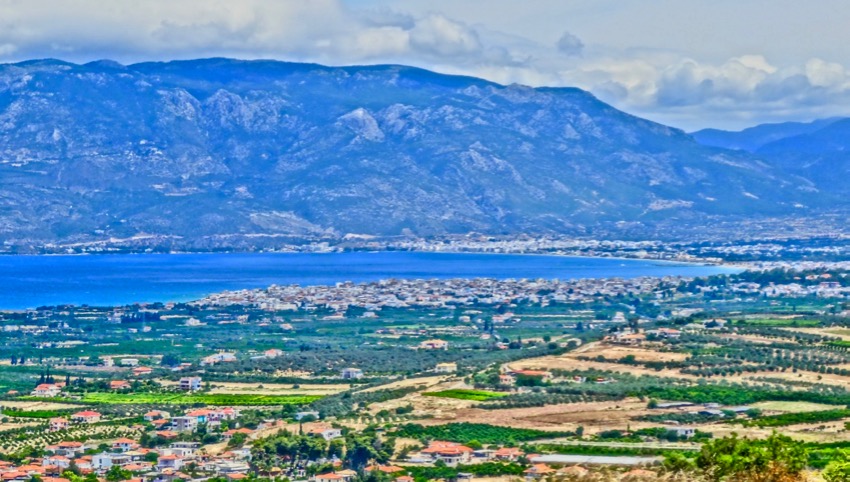
Helpful Corinth Tourist Information |
|||
|
Corinth is less than 2 hours drive from Athens and about 40 minutes from the town of Nafplio which is probably the best place to stay. There are restaurants and hotels and holiday homes nearby on the coast of the Corinthian Gulf. Many people include Corinth when they do a One Day Tour of the Argolis with George the Famous Taxi Driver or as part of a longer trip around the Peloponnesos. Fantasy Travel also offers a Half-Day Corinth excursion. The Fantasy Travel Mycenae - Epidaurus 1 Day Tour and Mycenae - Epidaurus 2 Day Tour and their 4 Day Classical Tour, their 5 Day Classical Tour and their 7 Day Grand Tour of Greece all include a stop in Corinth, though not necessarily Acrocorinth so ask. If you plan to go by bus they leave from the Kifissos Bus Station and continue on to Argos and Nafplio and you can also take the Proastiakos (Athens Suburban Rail) to Corinth though once you get there, making your way to the ancient site and Acrocorinth may be tricky. It probably would not hurt to take a taxi. See Bus Schedules. You can also rent a car through Swift Rent-a-Car and Fantasy Rent-a-Car and go on your own. For hotels in and around Corinth see Booking.com's Nafplio Hotel Search and Booking.com's Corinth Hotel Search. If you have a car my suggestion is to stay on the sea to the west of Corinth rather than right in the city. Use the map option on the 2 booking sites I mentioned. Be sure to visit these nearby places as well... |
|||
Help Support Matt's Greece Guides
Do you enjoy using my site? Have you found it entertaining as well as useful? If so please show your appreciation by booking hotels through the travel agencies and the links found on my Hotels of Greece site. The small commission I make on the bookings enable me to keep working and in most cases you won't find them any cheaper by searching elsewhere. You can find
hotels in Greece by location, price, whether or not it has a swimming pool, and see photos and reviews by using this link to booking.com which also contributes to my website when you book. If you are appreciative of all the free information you get on my websites you can also send
a donation through Paypal or Venmo
Join Matt Barrett's Greece Travel Guides Group on Facebook for comments, photos and other fun stuff. If you enjoy this website please share it with your friends on Facebook and other social media.

